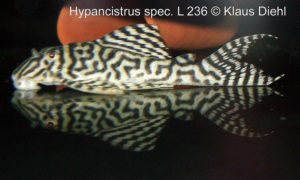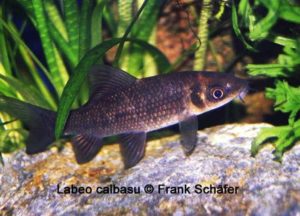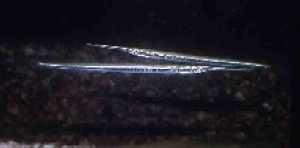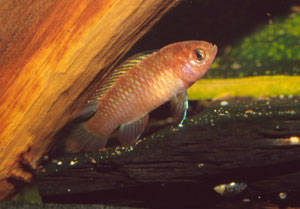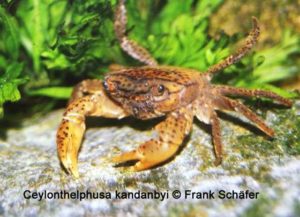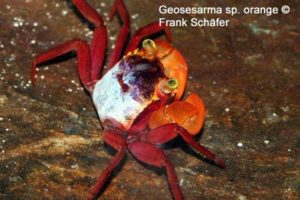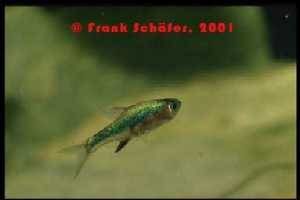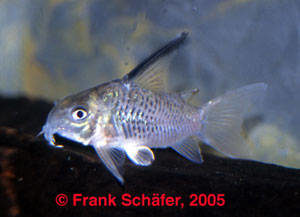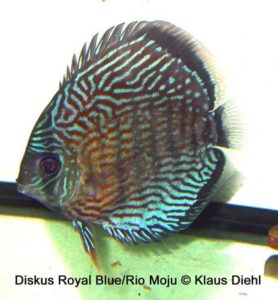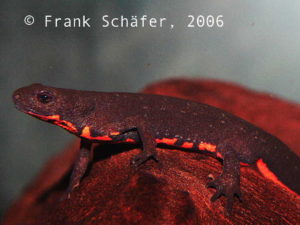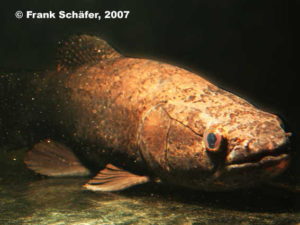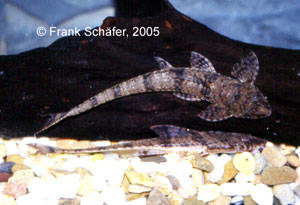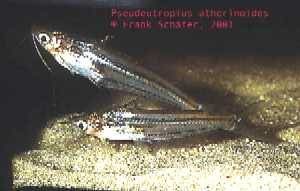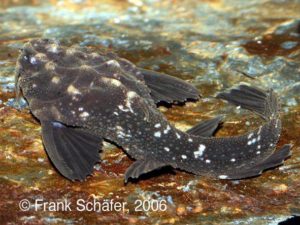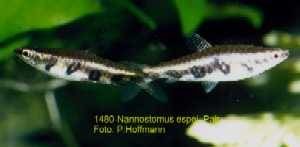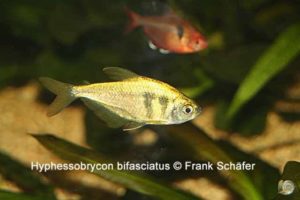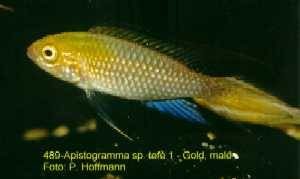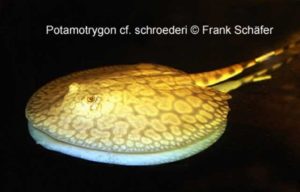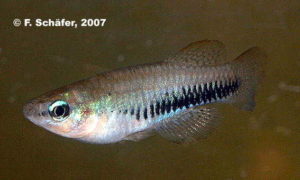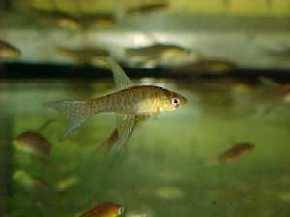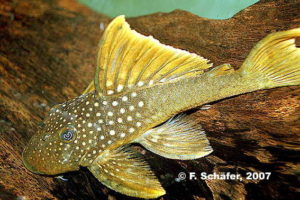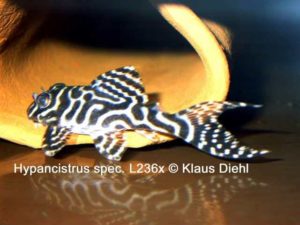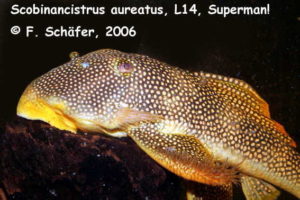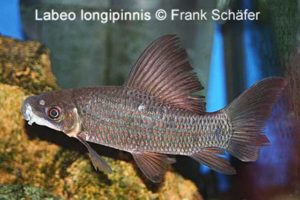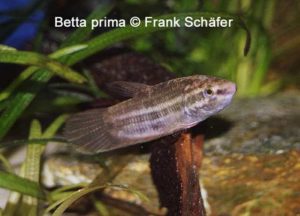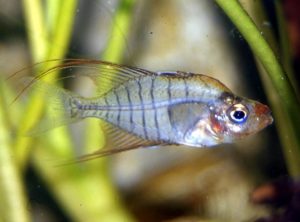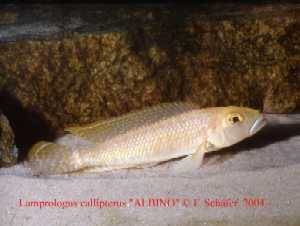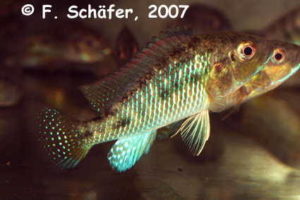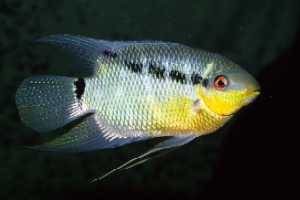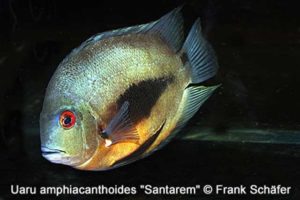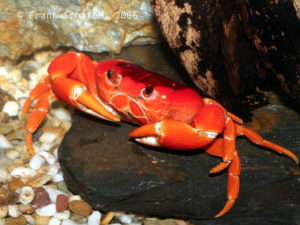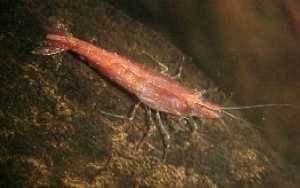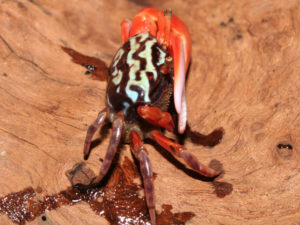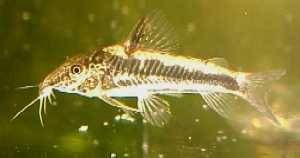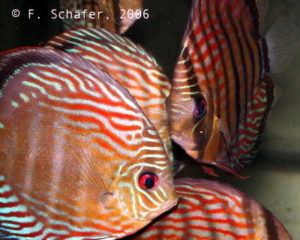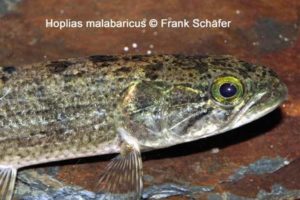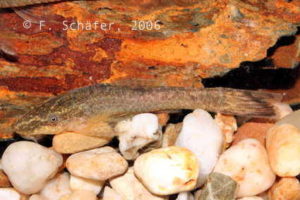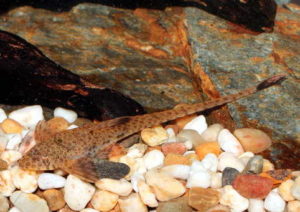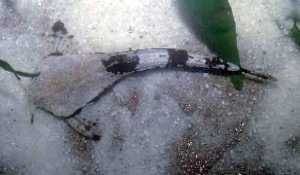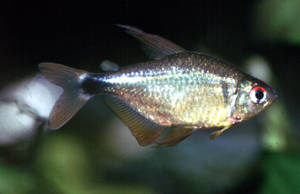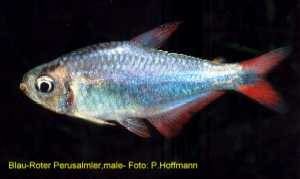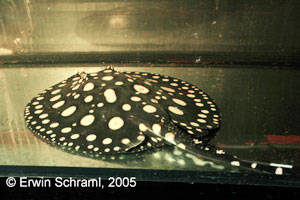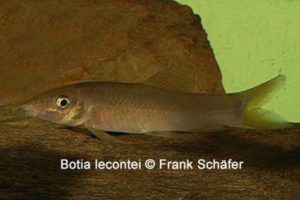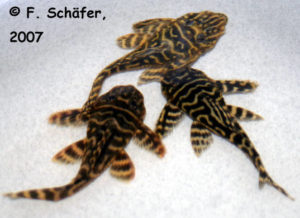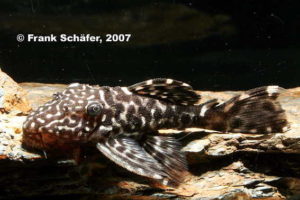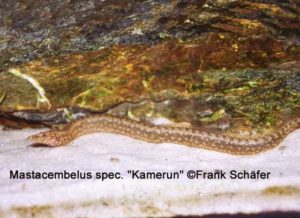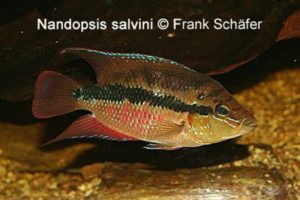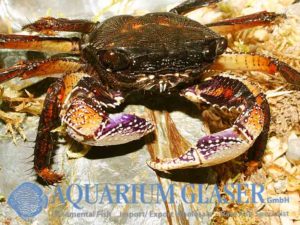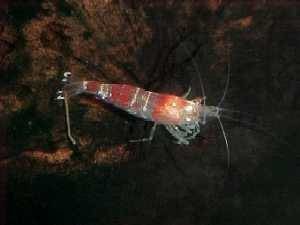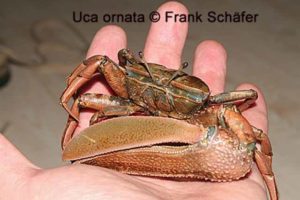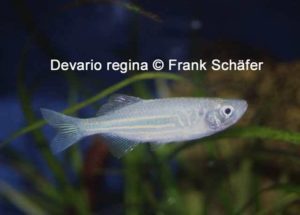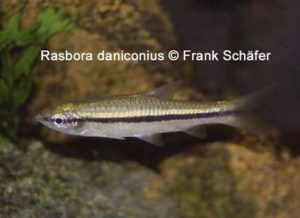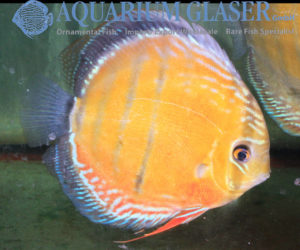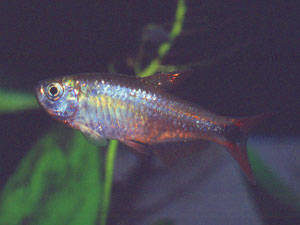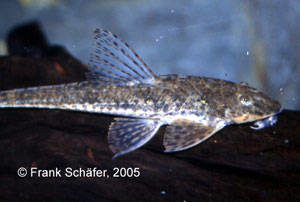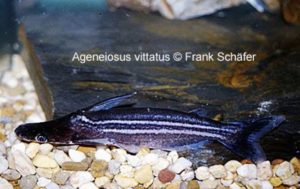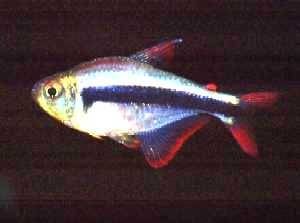„Simply the Best “: Some days ago we could import some of this beauties. With a size of approx. 10cm the white of the here illustrated male shows a fantastic intensity. It seems that one of imported fishes is a not less beautiful female, and so we hope to be able to offer some days […]
Fish Archive (2963)
-
-
Labeo calbasu
Labeo calbasu the Orange-fin shark is a real king sized labeo. In its homeland (Pakistan, India, Bangladesh, Myanmar, Nepal, Thailand and South West China) it is a fish for consumption and therefore of importance in the asiatic aquaculture. With a size of up to 1m it is not a fish for the “normal” aquarium. Aficionados […]
-
Potamorrhaphis guianensis
These fish belonging to needlefish (Belonidae) reach the aquariums of interested hobbyists only very seldom. These robbers, called halfbeak, come from almost all over Amazonia. You can find them also in the Orinoco catchment area as well as in the Guyana countries. These specialized surface fish are only suitable for the the hobbyists with restrictions […]
-
Dario hysginon
Compared with Dario dario this species is hardly known by the general aquarists, although the males who obtain and guard their territory are looking very beautiful. Although they do not display the coloration like D. dario, they definitely show the same intense red colour. Unfortenately D. hysginon only shows his full colour when he is […]
-
Ceylonthelphusa kandanbyi
The leopard crab Ceylonthelphusa kandanbyi represents an attractive addition to the offered crustaceans. This 1999 scientifically described species originates from Sri Lanka where it is found in the Bentota river system. According to statement of our supplier the animals were caught in the proximity of Mathugama city a town in the western part of Sri […]
-
Geosesarma sp. „orange“
March 2006: The mandarin crab, a further still undefined Geosesarma species, reached us these days from Sulawesi. It is characterised by a very intensive red-orange colouring of the legs and particularly the claws as well as bright yellow eyes. Thus it represents a beautiful coloured contrast to the last week introduced vampire crab. Whether a […]
-
Barbus jae
The Jae barb is one rarely out of central Africa imported dwarf barb. With scarcely four centimeters of length they attained full growth and show an attractive red coloration on their fins. The red hue of the fins is more weakly pronounced with the females; their body exhibits predominantly beige-brown tones. In addition the females […]
-
Rasbora axelrodi
One of the jewels for experienced aquarists is Sundadanio (former: Rasbora ) axelrodi. The fish on the photo belongs to the blue-green form from Anjungan, Borneo.(Photo F. Schäfer, Text K. Diehl)
-
Corydoras armatus „spotted“
April 2005: These beautiful animals where imported from Columbia. The literature however give Peru and Brazil as their place of origin. For more then 125 years ago these fish were described by Günther and since then hardly ever imported. The characteristic features of this catfish is the extreme long dorsal fin of which the first […]
-
Diskus Royal Blue/Rio Moju
If an increase of beauty and charisma of the at 01.02.06 introduced Diskus variant Red Inferno/Rio Moju is still possible, then by the Royal Blues originating from the same river. When first seeing these fishes I remembered the headline of an old “aquarien magazin” article. In January 1972 Eduard Schmidt Focke a famous german discus […]
-
Cynops orientalis
In its eastern chinese habitat the Chinese Fire Belly Newt Cynops orientalis inhabits small standing to slowly flowing overgrown waters. Females can get up to 10 cm long, the males remains with approximately 8 cm somewhat smaller. They can be kept predominantly aquatic, but a small land part with hiding places and climbing possibilities is […]
-
Hoplias macrophthalmus
With Hoplias macrophthalmus we could import from Colombia one of the biggest predatory fishes of the Amazon river system. Contrary to the regular imported Hoplias malabaricus these arrive only extreme rarely in the trade. As an adult with a weight of over 40 kg and a length of more than 120cm they belong to the […]
-
Rineloricaria cf. Eigenmanni
This fish came in together with Rineloricaria sp. „Colombia“ is however slightly smaller. This beautiful species has a characteristic black stripe pattern on the length of the ventral side of the body, after acclimatization in the aquarium. Bristles are not very strongly developed. This species is uncomplicated concerning keeping requirements. The raising of the fry […]
-
Pseudeutropius atherinoides
The „shark cats“ of the genus Pangasius are highly seeked for aquarium fishes, because their swimming behaviour reminds one on a shark. Sadly all species grow very fast and none of the species stays smaller than 50 cm, some even reach 150 cm or even more. For some time now so-called „mini-pangasius“ are introduced to […]
-
Amaralia hypsiura
January 2001: At present we can offer Amaralia hypsiura for friends of the extraordinary . This rarely dealt catfish attains full growth with approx. 15 cm length. It originates from the Amzon and there it feeds mainly, as gastric examinations of freshly caught fishes documents, predominantly the spawn of other fish. Fortunately they are not […]
-
Nannostomous espei
Up to now this ornamental tetra is only known from western Guyana/Southamerica in the lower course of Mazaruni River. Full-grown fish reach a total length of approx. 40mm. When putting on spawn the females are getting much plumper. By using their dish-shaped anal fin the males fix the eggs to a substrate (e.g. bottom of […]
-
Hyphessobrycon bifasciatus
The Yellow Tetra originates like its close related Von Rio Tetra from coastal rivers in southeast Brazil. With its pretty yellow basic colour it forms a beautiful contrast to it and other reddish characin species. As a schooling fish the Yellow Tetra should be kept only in larger swarms. Particularly in not too brightly lit […]
-
Apistogramma sp. Tefé 1 – Gold
The first golden animals were found among a bred shoal of young, approx. 14 days old Apistogramma sp. Tefé 1. From them a breeding phylum for further generations of Golden Apistogramma developed. Their growth is plainly slower than the growth of the normal Apistogramma sp. Tefé 1 and their breeding is generally more difficult. Their […]
-
Potamotrygon cf. schroederi
Recently we could import this strongly at Potamotrygon schroederi reminding ray from Colombia. Similar as P. schroederi it possesses a strong tail and bright points, which resemble a flower pattern. The Orinoco and its tributaries are the origin of the so called Flower – Rays. Their maximum size might be approximately 60 – 70 cm, […]
-
Aplocheilichthys katangae
From the Katanga province of the Congo we recieved Aplocheilichtys katangae. These non seasonal killies have a large distribution area in the central southern Africa. There they inhabit shallow, overgrown brooks and ponds. Their maximum size is approximately 6 cm. They feed on small water insects and crustaceans in tanks they can be fed with […]
-
Terranatos dolichopterus
May 2002: New arrival: german bred Terranatos dolichopterus, sailfin-killi (Aqualog “New World Killis, page 190 log-no: S27715). This fish comes from Venezuela, grows up to 5cm and should be kept in groups. The bottom of the tank should be peat, because they “dive” into the bottom when they spawn. (Photo F. Schäfer, Text K. Diehl)
-
Baryancistrus demantoides L 200 High Fin
From Colombia we could import expressed beautiful L 200 High Fin. Now we have very attractive partially completely yellow colored specimen of the species Baryancistrus demantoides in stock. They will get only about 15 cm long and remain thereby substantially smaller than the also with the number L the 200 labeled Hemiancistrus subviridis. Compared with […]
-
Hypancistrus spec. L 236x
November 2006: At Christmas we would like to present a star at the catfish heaven. We can offer some offspring of the queen imperial zebra Hypancistrus spec. L 236x, a beautiful and very looked for species. They come from a German breeder, who had the luck that the two from us imported animals formed a […]
-
Scobiancistrus aureatus L 14
December 2006: Last week received we a really impressive, male Scobiancistrus aureatus. With a length of about 30 cm it might be attained full growth. The strong spines on the gill cover (Interopercularodontodes), as well as on their pectoral fins are remarkable. As most L-catfishes from the Rio Xingu they like warmer waters, for their […]
-
Labeo longipinnis
december 2005: For the first time in Europe we can present Labeo longipinnis from the Congo River to you. This about 30 cm long growing Labeo is not noticeable by a particularly spectacular design or colour. Due to its lively manner, beautiful form and fins it can become nevertheless a genuine “eye-catcher” in the community […]
-
Betta prima
Betta prima originates from South East Thailand and Cambodia and is a member of the Betta pugnax group. They are found foraging along the dense vegetation of brooks, swamps and calm rivers. B. prima is a small species, they can reach the size of about 6 cm. They like well planted, and since they are […]
-
Mastacembelus greshoffi
Some time ago we could import Mastacembelus greshoffi from the Congo. Here we have a spiny eel getting approximately 35 cm long, which occurs over rocky bottoms in rivers and lakes, also in rapids. Spiny eels are intelligent fish, they show a multiplicity of interesting behaviours. They also can become amazing tame and eat then […]
-
Pseudophallus mindii
Pseudophallus mindii is a short snouted pipefish, which reached us as a by-catch in two exemplars. Their distribution contains central and tropical South America, where it is found predominantly in freshwater habitats. Adults were caught from estuaries and mangrove areas too, while planktonic juveniles have been collected well offshore at sea. As other pipefishes and […]
-
Gymnochanda filamentosa
This glass perchlet is a rare inhabitant in German aquaria. This species originates from Malaysia and Singapore. The male from G. filamentosa is easily distinguished from other Chanda species by the elongated fin rays of the dorsal and anal fins. The maintenance of these fish is not very complicated and a bit of salt added […]
-
Lamprologus callipterus ALBINO
August 2004: Now available: Lamprologus callipterus ALBINO. After several years, one of our breeder was successful in breeding this species. We have this fish for the first time in stock. You will find here more details soon.(Photo F. Schäfer, Text K. Diehl)
-
Pseudocrenilabrus philander
May 2007: From the Congo we received Pseudocrenilabrus philander. The fish originate from the upper parts of the Congo river (Lualaba). Their area of circulation covers nearly the entire southern Africa, where they are to be found in practically all types of waters. As mouthbreeders in the female gender their courtship and broodcare run after […]
-
Mesonauta insignis
This cichlid, which is growing up to approx. 20cm is living along the catchment area of the Orinoco, whereit mostly lives in slowly flowing or even standing waters. You often find it right in front of the shore, where it inhabits the upper water layer. Regarding the nutrition M. insignis is totally uncomplicated, because these […]
-
Uaru amphiacanthoides -Santarem-
At present we can offer this magnificent variant of Uaru amphiacanthoides originating from Santarem. The fish impress by their metallical resplendent body and the cherry red eyes. All Uarus are expressed plant lovers. Beside a meaty nutrition vegetarian food should be offered. The food spectrum is large, almost all fruit and vegetables are accepted and […]
-
Gercarcinus ruricola
This splendid land crab (Halloween-Crab, Gercarcinus ruricola) occurs in two colour variants, specifically with red or white base coloration. The colour variation involves both sexes. A mixed pair lived together in harmony for several weeks in my terrarium. These creatures are essentially vegetarian, but will occasionally take frozen foods intended for aquarium fishes, eg bloodworm. […]
-
Neocaridina sp FIRE/CHERRY
July 2004: Yesterday we got a limited number of this beautiful shrimp, which belongs to the family of Neocaridina. This type was imported one year ago, but also only in small numbers. They do not demand special water parameters and can be easily fed with common fish food. They can be kept in community tanks, […]
-
Uca annulipes
May 2005: One of the most beautiful fiddler crab, Uca annulipes has been available now. Fiddler crabs, a family of 65 species, live worldwide in tropical and subtropical areas where they inhabit beaches and swamps. They reach a length of no more then 2.5 to 3 cm. The male animals have one large and often […]
-
Devario assamensis
Some of the about 35 Devario species are found regularily in aquaria, others like Devario assamensis are rather rare. Therefore we are very happy to be able to offer you for the first time german bred Devario assamensis. Here it is about magnificent colored, circa 10 cm long getting barbs, whose origin is eastern India. […]
-
Corydoras baianinha
March 2003: Some weeks ago we received a few pieces of Corydoras baianinha. This extreme rare Corydoras only occurs in a little number of small streams in the south of Brasil. The population of Cordoras baianinha is very much in danger, because its living space was already largely distroyed by environmental pollution and forest clearing! […]
-
Diskus Semi royal, Rio Moju
Like the introduced before Discus from the same area (Rio Moju) the “Semi Royal” variant shows a strong red coloration at the seam of their body and their fins. With them the wave pattern is nearly continuous distributed over the entire body. (Photo F. Schäfer, Text K. Diehl)
-
Hoplias malabaricus
“Here's lookin' at you, kid,” – but be careful. Otherwise it could happen that it will be the very last what a tank mate will be looking at. Under these beautiful green eyes are not less impressive teeth that makes the wolf fish Hoplias malabaricus a feared hunter. The owners of these from Costa Rica […]
-
Hisonotus notatus
July 2006 From southeast Brazil we could import some rare pieces from the relationship of the popular Otocinclus species. In its homeland Hisonotus ornatus inhabits with weeds infested waters. It may not be kept too warm. 24°C probably represents the reasonable upper limit. The requirements for their maintenance do not differ from those of the […]
-
Rineloricaria melini
As a further german bred rarity we can offer Rineloricaria melini at present. Our specimen of the probably most attractive Rineloricaria species have with 9 – 12 cm length already attained full growth and are of outstanding quality. Their origin is the area of the Rio Negro where they live in black water biotopes. Like […]
-
Bunocephalus sp. „Black/White“
The banjocat new imported from Peru immediately attract attention due to their interesting colouring in contrast to other species of the same relation circle. Therefore some animals are almost unicoloured white while other specimens mainly show some irregular black markings. The care of this species does not differ from that of other relatives of this […]
-
Trichomycterus alternatus
One of the in the aquarium most easy to keep pencil catfishes is Trichomycterus alternatus. This species, originating from the Rio de Janeiro region, reaches an overall length of for 10cm and can be maintained in aquaria starting from 60cm length. These very shy fish, reminding in their appearance of our in Europe native Stone […]
-
Hyphessobrycon cf. loweae
It was illustrated on the homepage of Canadian fish exporter “Below Water” and designated as “Kitty” Tetra (“a new Hemigrammus-species, caught in Mato Grosso in November 2000). It is presented as Hyphessobrycon loweae in the February/March-issue of “Aquaristik Fachmagazin & Aquarium heute”. According to Dr. Géry there are “good correspondences” with Hyphessobrycon loweae (Costa & […]
-
Hyphessobrycon sp. Blue Red Peru
Once again we could discover a new and very beautiful tetra at AQUARIUM GLASER several months ago. It should be another undefined tetra species (from Peru), probably a type of Hyphessobrycon. The fish were almost full-grown and the sexes rather sure to distinguish. We bought three pairs, which got used to our aquarium conditions without […]
-
Potamotrygon leopoldi
The Black- or Eclipse-Ray is an endemic species from the Rio Xingu in Brazil. This is definitely one of the most beloved rays in the aquatic hobby. This ray is relatively easy to maintain. He will adapt fast to his new captive surroundings and will start eating quickly. This species can be housed very well […]
-
Yasuhikotakia lecontei
From the watershed of the Mekong originates this circa 15 cm long getting loach. The name red finned loach is something misleading, since not all animals show this colouring in all stages of age. During their development they change colours and pattern. Young animals usually exhibit a pattern of stripes which disappears during ageing. In […]
-
Hypancistrus spec. L 340
Freshly arrived from Colombia: the Megaclown L 340. We can offer one of the most beautiful and at the same time most variable Hypancistrus “species” in very good quality. The animals already reached maturity, so that the outstanding contrast should remain. In their requirements for maintenance they do not differ from their Brazilian cousins, warm, […]
-
Leporacanthicus sp. „NEW“
April 2007: We received a particularly beautiful easter surprise this week from Colombia. The representative of the genus Leporacanthicus illustrated here is probably the first and only specimen on the market. It reminds of the in the Orinoco occurring L 240 and L 241, as well as of Leporacanthicus cf. “Venezuela”. But its white spots […]
-
Mastacembelus spec. „Kamerun“
This spiny eel reached us from Cameroon. The classification to a species was so far not possible for us. Since spiny eels predominantly are found on sandy to muddy bottom, they require a sand substrate in which to dig and hide. Flat rocks are also good for these fish to burrow under; just make sure […]
-
Nandopsis salvini
December 2006: At present we can offer a very beautiful, strongly red coloured variant of Nandopsis (Cichlasoma) salvini to you. They origin from South Mexico, Belize and Guatemala, where they live in to the Atlantic ocean heading streams. Like most Central American cichlids they are very easy to keep in middle hard water at pH […]
-
Cherax lorentzi
In its shining armour Cherax lorenzi reminds of a medieval knight, who is on its way to the tournament. With a size of 12 cm it can be kept very good in aquariums starting from 100 cm length. Contrary to some of its relatives Cherax lorenzi does not seem to harm other tank mates. Therefore […]
-
Goniopsis pelii
June 2006: The mangrove crab Goniopsis pelii reached us from the Atlantic coast of Africa. Their orange and blue coloured claws are very remarkable. They owe their name to the mangrove woods where they naturally occur. This by water and land affected biotope has to be reproduced in the terrarium, since they need both habitats […]
-
Neocaridina sp RED CRYSTAL SHRIMP
December 2002: Here we have it: german bred red crystal shrimp. We only got a few pieces, but we expect a limited quantity in the near future. This shrimp of the family Neocaridina is easy to keep and can be kept with not too big growing fish in a community tank (Photo F. Schäfer, Text […]
-
Uca ornata
January 2006: For the first time in Germany: The fiddler crab Uca ornata. We are proud to introduce this new species to the pet market. We got only few animals from Ecuador, hope however for further imports of this species. Further information for the maintenance of this at the Pacific coast from Ecuador to Nicaragua […]
-
Devario regina
The Queen Danio (Devario regina) is a tropical fish belonging to the minnow family (Cyprinidae). Originating in India, Myanmar, Thailand, northwestern Malaya, and the Mekong basin it is quite rarely seen in our tanks. Other species often found in the same locality as D. regina are Puntius lateristriga, Rasbora paviei, various Poropuntius, Neolissochilus, Barilius, Nemacheilus […]
-
Rasbora daniconius
The slender rasbora inhabits a very large area in Southeast Asia. From the Malaysian peninsula to the Mekong and the Indus it occurs in the a variety of habitats: channels, ponds, flooded (rice) fields and slowly flowing rivers. Due to the enormous area and the adjustment to different waters types it can be assumed that […]
-
Diskus „Nhamunda rosé”
Nhamunda Rosé is the trade name of a strain of the brown discus Symphysodon aequifasciatus axelrodi originated in the Rio Nhamunda (northern influent of Amazon, west the city Alenquer). Now again some Nhamunda Rosé are available. Characteristic for this variety is the partially laminar high red part of the brown primary colour. Thus they are […]
-
Hasemania sp. „Red“
This small characin is a very attractive fish and a fast swimmer as well. It could be determined as a representative of the Hasemania genus, because it misses the characteristic adipose fin, which is one of the features that determine characins. Up to now we used to have only one species belonging to this genus, […]
-
Rineloricaria sp. „Colombia“
A remarkable species which came in in one of our import from Colombia. These fishes also originate from the Rio Chacu in the northern tip of the country. Because of the many bristles of the male this species has been falsely determined as Rineloricaria latirostris. A comparison with the pictures (see Mergus Catfish Atlas Part […]
-
Ageneiosus vittatus
July 2002: For the first time we could import Ageneiosus vittatus from Peru. Slopehead catfish of the genus Ageneiosus are particularly noticeable by its strongly flattened head. These predators can reach an overall length of 30 cm. For the maintenance large basins are necessary. A dark bottom, some stones and bogwood should be brought in […]
-
Hyphessobrycon sp. Red Fin Peru
This fish is an extreme attractive tetra of the species Hyphessobrycon. There is no exact scientific definition of this kind yet, which grows up to 50mm minimum. Its body colouring looks a bit like a crossbreeding of three-banded-tetra (Hyphessobrycon heterorhabdus) and the black neon tetra (Hyphesobrycon herbertaxelrodi). This tetra has also got the red upper […]





